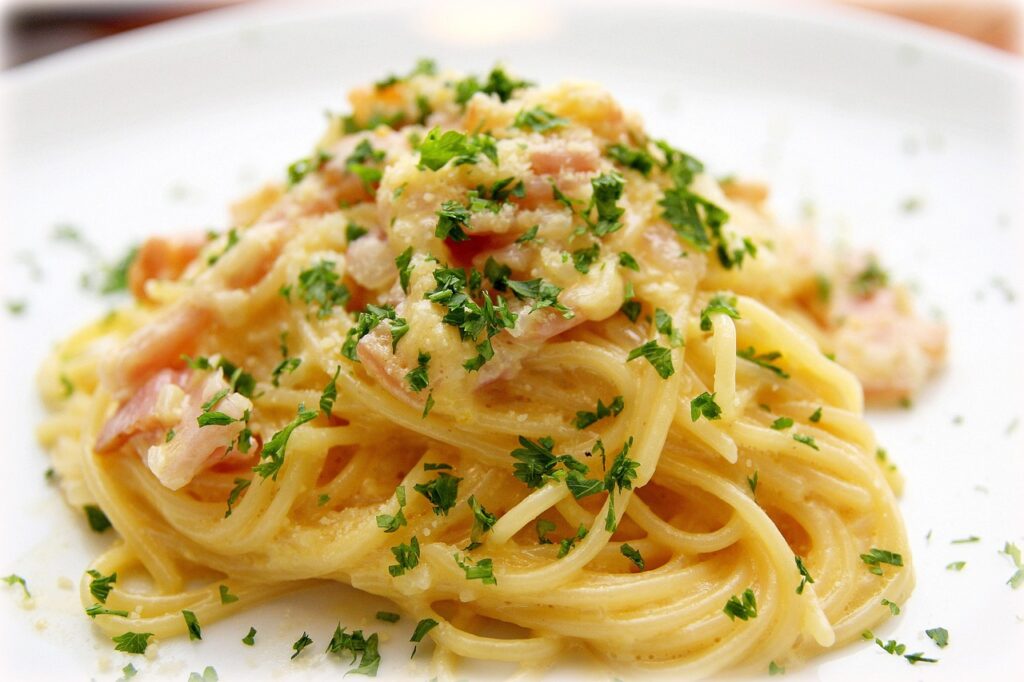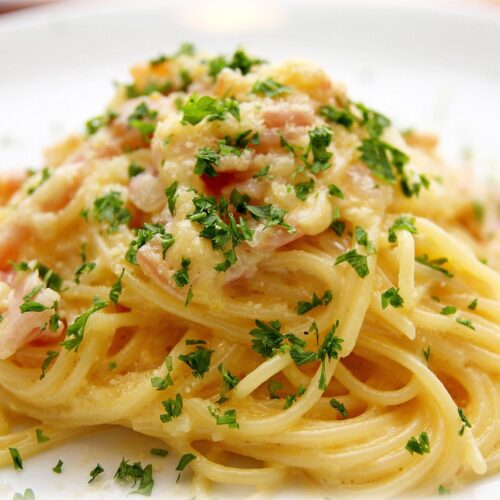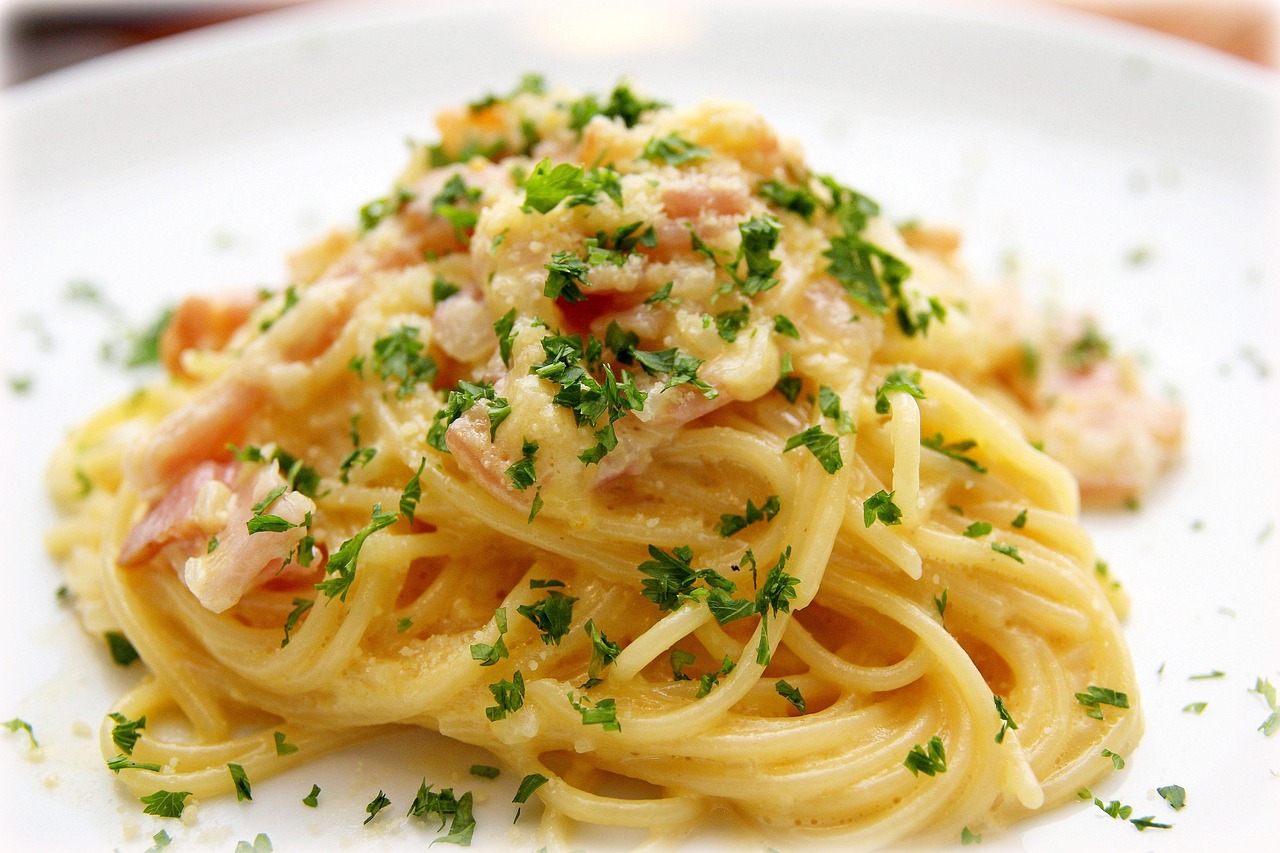Classic Carbonara is a creamy Italian pasta dish made with eggs, cheese, pancetta, and black pepper—no cream required. how to make authentic Carbonara with simple ingredients and expert tips.

Ratings 05

What Is Carbonara?
Rome is where all the Italian Cuisine pasta dish carbonara initially popped up. It’s known for its creamy, savory sauce made without cream, using just a few simple ingredients. eggs, cheese (typically Pecorino Romano or Parmesan), pancetta (or guanciale), and black pepper.
01. Key Features
- No cream: The creamy texture comes from emulsifying the eggs, cheese, and starchy pasta water.
- Traditional meat: Usually made with guanciale (cured pork cheek), though pancetta or bacon are common substitutes.
- Pasta type: Typically served with spaghetti, but also works well with fettuccine, bucatini, or rigatoni.
- Flavor: Silky mouthfeel, rich, salty, and peppery.
02. Origin
Carbonara is believed to have been created in mid-20th century Italy, possibly inspired by pasta dishes made by coal workers (the name “carbonara” may come from carbone, meaning “charcoal”).
Health Benefits Of Carbonara
While Carbonara is a rich and indulgent dish, it does offer some nutritional benefits when enjoyed in moderation:
01. Good Source Of Protein
Eggs and pancetta/guanciale provide high-quality protein, which helps with muscle repair and overall body function.
02. Rich In Calcium
Parmesan or Pecorino Romano cheese is high in calcium, supporting healthy bones and teeth.
03. Energy Boosting
Pasta is perfect for active people because its carbohydrates offer a rapid and long-lasting energy boost.
04. Healthy Fats
The fats from eggs and cured meats can help with nutrient absorption and hormone production (though they should be balanced with healthier fats in your overall diet).
05. No Added Sugar
Traditional Carbonara has no added sugars or processed sauces, making it cleaner than many commercial pasta dishes.
06. Health Considerations:
- High in saturated fat and sodium: Because of the cheese and cured meats, it can be high in cholesterol and salt.
- Calorie-dense: Best enjoyed in controlled portions as part of a balanced diet.
Tips For Making Carbonara
Follow these expert tips to make an authentic and silky Carbonara every time:
01. Use Room Temperature Eggs
Let eggs sit at room temperature before mixing with cheese—this helps create a smoother sauce and prevents curdling.
02. Whisk Eggs And Cheese Well
Beat eggs thoroughly with grated Parmesan or Pecorino Romano to form a creamy, uniform base.
03. Save Pasta Water
Reserve at least ½ cup of hot pasta water. The starch helps emulsify the sauce and adds creaminess without needing cream.
04. Remove Pan From Heat Before Adding Eggs
Never add the egg mixture over direct heat, or it will scramble. Mix the eggs with the hot pasta on medium heat, then gently.
05. Use Guanciale If Possible
For authentic flavor, use guanciale (cured pork cheek). If unavailable, pancetta or thick-cut bacon are good substitutes.
06. Pepper It Generously
Freshly cracked black pepper is essential to Carbonara’s signature flavor—don’t be shy with it!
07. Serve Immediately
Carbonara is best served right away while the sauce is hot and creamy. It doesn’t reheat well.
FAQ Carbonara
Here are some frequently asked questions about Carbonara:
01. Can I Use Cream In Carbonara?
Traditionally, no. Authentic Italian Carbonara does not include cream. The starchy pasta water, cheese, and eggs start giving this a creamy texture.
02. What’s The Best Pasta To Use For Carbonara?
Spaghetti is classic, but fettuccine, bucatini, linguine, or rigatoni also work well.
03. Can I Make Carbonara Without Meat?
Yes! You can make a vegetarian version by omitting pancetta and adding mushrooms, smoked paprika, or sun-dried tomatoes for a savory flavor.
04. Why Did My Carbonara Sauce Scramble?
The egg mixture was likely added to pasta that was too hot or still over the flame. Always remove from heat before mixing in the egg-cheese mixture.
05. Can I Use Whole Eggs Or Just Yolks?
Many recipes use whole eggs, while some use a mix of whole eggs and extra yolks for a richer, silkier sauce.
06. Is Carbonara Safe To Eat With Raw Eggs?
The eggs are gently cooked by the heat of the pasta, but if you’re concerned, use pasteurized eggs for extra safety.
07. Can I Reheat Carbonara?
It’s best fresh.The sauce may become dry or scramble if it is reheated. If needed, reheat gently with a splash of water on low heat or in the microwave

Carbonara
Ingredients
- 200g (7 oz) spaghetti or fettuccine
- 100g (3.5 oz) pancetta or guanciale (or bacon, diced)
- 2 large eggs
- 50g (1.75 oz) grated Parmesan or Pecorino Romano
- 1–2 cloves garlic (optional)
- Salt, to taste
- Freshly ground black pepper, to taste
- 1 tbsp olive oil (if using leaner bacon)
Instructions
Cook The Pasta
- Boil water in a large pot with a generous pinch of salt.
- Cook spaghetti until al dente, according to the package instructions.
- Reserve ½ cup of pasta water before draining.
Prepare The Sauce Base
- In a bowl, whisk together eggs, cheese, and a pinch of black pepper until smooth. Set aside.
Cook The Meat
- Heat a pan over medium heat. Add olive oil (if needed), then add pancetta or bacon.
- Cook until crispy and golden brown. Optionally add minced garlic for flavor, then discard after sautéing.
Combine Pasta And Sauce
- Add the hot drained pasta to the pan with the meat (remove from heat).
- Quickly pour in the egg-cheese mixture and toss thoroughly.
- Add a bit of reserved pasta water gradually to create a creamy sauce—do not scramble the eggs.
Finish And Serve
- Add more cheese and pepper to taste.
- Serve immediately while hot and creamy.
-
Carbonara
Classic Carbonara is a creamy Italian pasta dish made with eggs, cheese, pancetta, and black pepper—no cream required. how to make authentic Carbonara with simple ingredients and expert tips. Ratings 05 What Is Carbonara? Rome is where all the Italian Cuisine pasta dish carbonara initially popped up. It’s known for its creamy, savory sauce made…


Leave a Comment